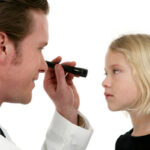Most patients assume that if they have red, irritated, or teary eyes that they have an eye infection commonly called “pink eye”, but is it really an infection or could it be something else?
What Is Pink Eye?
“Pink eye” is a non-medical, common term, used to describe the medical disease conjunctivitis. Conjunctivitis is the inflammation of the conjunctiva, which is the thin layer of tissue the covers the white part of the eye and lines the inside of the eyelids. When the conjunctiva becomes inflamed the small delicate blood vessels in it swell causing the normally clear tissue to turn a dark red or brilliant pink color – hence the name: pink eye.
Most Common Types of Conjunctivitis
Allergic
This type of conjunctivitis occurs mostly in individuals who have sensitivity to environmental allergies or hay fever. It is seasonal, occurring mostly in the springtime as the flowers, plants, and trees begin to produce and expel pollen.
Symptoms a patient with allergic conjunctivitis may experience include: excessive tearing, itching, and redness. Occasionally, swelling of the eyelids can occur.
Treatments typically consist of antihistamines. These can be administered either orally by pill, or topically by eye drops.
Bacterial
This type of conjunctivitis is an infection, and is the most common. Coming into contact with another person or surface that is contaminated by the bacteria is the most common way of becoming infected. It can also be caused by sinus or ear infections.
Symptoms a patient with bacterial conjunctivitis may experience include: thick mucus or pus discharge. This discharge may be yellowish or green in color, or have no color at all. Most patients report having their eyes “glued” shut when they first wake from sleep. Swelling of the eyelids is common, as is slightly blurred vision due to the amount of thick mucus in the eyes.
Treatments for bacterial infections normally require antibiotics administered through topical eye drops or ointments to speed up the healing process. Left untreated, a bacterial infection will typically clear up in a matter of two to three weeks. Rarely serious corneal (front surface of the eye) issues will result, but if you suspect an infection you should seek the advice of an ophthalmologist
Viral
This type of conjunctivitis is also an infection, and is highly contagious. Not only are the sensitive tissues of the conjunctiva affected, but frequently the cornea is as well. Transmission of the virus is typically spread through person-to-person contact, or can spread to the eyes from a viral head cold.
Symptoms a patient with viral conjunctivitis may experience include: redness, watery and profuse tearing, and light sensitivity.
Treatments for viral conjunctivitis are limited. Most topical eye drops prescribed to a patient are more to keep the affected eye comfortable as the virus runs its course. Typically the infection will last one to three weeks. During this time it is important to adhere to strict hand washing policies. Also patients should not share pillows and wash linens daily to prevent the spread to others in their household.
Due to the highly contagious nature of viral conjunctivitis, it is advised that children should be kept home from school, and any one who works closely with people should limit the time they spend in contact with others. This is especially true of health care workers who may expose the virus to patients with already limited immune systems.
There are other types of conjunctivitis that are not as common as the ones outlined here. As with any infection, you should seek the advise of a medical ophthalmologist should you feel that you have an eye infection.
Could My Red Eyes Be Caused By Something Else?
There is always the chance that your red and irritated eyes are caused by something other than infections. Some other common causes of red eyes are:
Dry Eye Syndrome (Keratoconjunctivitis sicca)
This syndrome is caused by a break down of the lipid layer in human tears, and is common in the older population and among people who wear contact lenses on a daily basis.
Possible symptoms that a patient with dry eyes may experience are photophobia (light sensitivity), increased tearing, a burning sensation, and redness. Often times, patients who suffer from chronic dry eyes will complain of blurred vision since even tear coverage of the cornea is a major factor in clear vision.
Treatments for dry eyes vary due to the extent of dryness. For the most part it can be managed by the daily application of over the counter artificial teardrops, gels and/or ointments. These drops help to replace the thicker tears, which the body no longer produces as it ages.
Some patients find that OTC medications alone do not reduce or eliminate their symptoms. For these patients an ophthalmologist may prescribe a medicated eye drop, or in extreme cases may recommend minor surgery to plug or permanently close the tear duct.
Eye Lid Disorders
Ectropion – Is the turning outward of the eyelid, exposing the sensitive conjunctiva tissues of the eye. This is caused by age-related changes to the eyelids and tissues, and because the eyelid (normally the lower lid) turns away from the eye, the eye will not completely close causing the cornea and surrounding tissue to be exposed for long periods of time. Symptoms typically include: Foreign body sensation in the affected eye, irritation, and redness. Treatment for Ectrpoion is always surgical.
Entropion – Is the turning inward of the eyelid. While this disorder doesn’t expose the cornea or conjunctiva tissues, redness and irritation usually result from the eyelashes. With the eyelid (again normally the bottom lid) turned in towards the eye, eyelashes will brush up against the cornea resulting in possible abrasions or scratches. This condition is called trichiasis. A trained ophthalmologist can remove the lashes causing the irritation and treat any resulting abrasions, but without surgical repair of the entropian, the lashes will regrow and the problem will likely return.
In addition to eyelid disorders and dry eye syndrome there are still many, although less common, things that can cause a red, irritated eye, some of which could cause damage and potential vision loss. Medical evaluation of your symptoms is always recommended to get a proper diagnosis and/or treatment.
What precautions should I take if I have a red eye?
If you feel like your eyes are irritated, you first line of defense if to take note of your symptoms. If you rarely have red, irritated, or teary eyes make a physical list. Some questions to ask yourself are:
Are your eyes just red or do they feel like something is in them?
Do your eyes: Itch, tear or burn?
Is there any discharge, or were your eyes glued together when you woke up this morning? If yes, what color is the discharge or mucus?
Are you sensitive to light?
When did you first notice the symptoms? Have they gotten worse or better as time has passed?
Have you tried any remedies (OTC artificial tears, warm or cold compresses, flushing your eyes with water or sterile solution)? Did they help?
Do you wear contact lenses? If yes, did removing them help the problem?
Special note to Contact lens wearers – Do not put your contacts back into your eyes until they are clear of redness and irritation. If your eyes do clear up, be sure to put a new pair of contacts in your eyes. If you wear non-disposable, or rigid gas permeable contact lenses, make sure that you thoroughly clean them before putting the lenses back into your eyes.
Use your answers to relay your complaints and symptoms to your ophthalmologist office when you call. Remember it is important to contact your doctor if you suspect that you may have an infection. Remember that if you do have an infection, you are more than likely contagious. Be sure to wash your hands every time you touch your eyes, disinfect reasonable surfaces you have come into contact with (Tables, phone receivers, etc), and wash your bed linens.
What If I Don’t Have An Ophthalmologist?
Most ophthalmologists are listed in the phone book or your primary care (family practice) physician can recommend or refer you to one. Also your health insurance will have a list of eye care physicians in your area that are covered by your insurance plan.
Keep in mind that not all red or pink eyes are infections, however it is not something that most people can determine on their own at home. It is always best to treat a red eye as if it is possibly an infection. Wash your hands, remove your contacts if you wear them and contact your ophthalmologist as soon as possible. Having the correct information about your symptoms when you call the doctor’s office will not only expedite your call, but in some cases a treatment can be recommended over the phone saving you a trip to the office.





